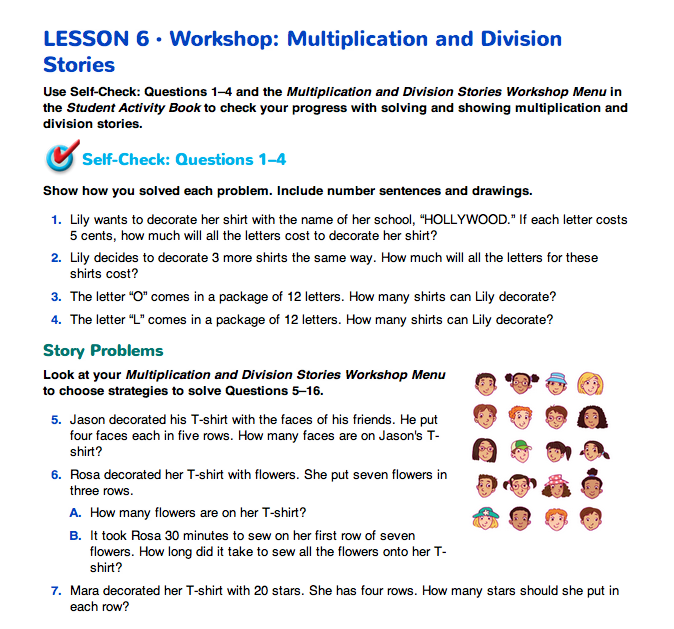Share and Compare Strategies. Distribute the Design Your Own T-Shirt Master from Lesson 1 in the Teacher Guide. Ask students to design a T-shirt with the school name on it. Give students a few minutes to draw and design a T-shirt.
- If it cost 5 cents for each letter, how much would it cost to put the school name on your shirt? Tell us how you decided. (Possible responses: “JACKSON” on one shirt would cost 5 × 7 = 35 or 5 + 5 + 5 + 5 + 5 + 5 + 5 = 35 cents; I skip counted by 5 seven times, once for each letter: 5, 10, 15, 20, 25, 30, 35.)
- If there are [20] students in our class, how much would it cost to put the school name on shirts for all the students in our class? Tell us how you decided. (700 cents. Each shirt costs 35 cents. 35 cents × 2 tens of students = 70 tens or 700 cents. For a class of 20 students, the shirts would cost 700 cents or $7.00.)
Refer to Math Practices Expectation 5 on the Math Practices page in the Student Guide Reference section. Use the following discussion prompts to set expectations for showing solution strategies to multiplication and division problems.
- I hear your answers, but how can you show how you got the cost of the letters for one shirt? (Possible responses: I could show my skip counting on the number line; write a number sentence that shows how I add 5 each time; draw a picture of the letters and the costs and skip count.)
- How can you show how you got the cost of the letters for the entire class? (I can write a number sentence showing my thinking; draw a picture; show the skip counting on a number line.)
Ask a few students to share their solution strategies with the class. As students share, ask:
- Can you tell what [student name] did to solve the problem? What did [he] do first? What strategy is [student name] using?
- Who has a different strategy? Show us.
The work in this Workshop is varied by practice, not by content. You will not see problem sets denoted with symbols. Rather, students will vary the strategies they use, focusing on areas in which they need more practice.
Self-Check and Organize for the Workshop. Introduce the scenario in Self-Check: Questions 1–4 in the Student Guide. Assign students to solve the problems with a partner. These questions serve two purposes. First, they clearly communicate the content of the related targeted practice to students. Second, they help students quickly self-assess their progress with the Expectations.
Ask students to use Self-Check: Questions 1–4 in the Student Guide to assess their ability to solve and represent multiplication and division problems in stories, drawings, and number sentences [E2], multiply and divide using mental math strategies [E3], solve two-step word problems [E4], and represent their solution strategies using number sentences and drawings [E5].
After students complete Self-Check: Questions 1–4, discuss each of the questions with the whole class. Ask students to share their solutions and explain their reasoning.
Facilitate a class discussion of students' solutions using prompts similar to the following:
- What might a drawing look like for [Question 1]? (See Figure 2.)
- What are some strategies to solve [Question 1]? (Some possible responses: Skip count by 5 nine times; I know 5 × 10 is 50. So, 5 × 9 = 50 − 5 = 45; see Figure 2.)
- What number sentences can you write to show your solution strategy to [Question 1]? (Possible responses: Since I skip counted by 5, I wrote a repeated addition sentence to show my solution, 5 + 5 + 5 + 5 + 5 + 5 + 5 + 5 + 5 = 45; I used ten. I wrote 5 × 9 = 50 − 5 = 45 to show my solution.)
Ask several students to share the strategies they used to solve each problem.
Have students refer to the Multiplication and Division Stories Workshop Menu in the Student Activity Book. Ask student to think about the “Can I Do This?” questions in the left-hand column of the Workshop Menu.
- Students who are “Working On It” need some extra help and should place an “X” in that column. These students will need additional scaffolding to develop these practices.
- Students who are “Getting It” just need more practice and should place an “X” in that column. More practice will help these students to continue developing these practices.
Check students' choices to see how well they match your own assessment of their progress on the related Expectation(s). Organize students into groups using their responses on the Workshop Menu as a guide. See the TIMS Tip. Assign Questions 5–16 in the Student Guide.

Organizing students to work collaboratively can help provide some of the scaffolding students need. Collaborative groups can be organized in a variety of ways, and each way has advantages and disadvantages.
Groups organized by similar needs. Organizing groups in this way can be frustrating to some students, but that struggle can actually provide the needed motivation and context to develop certain models and skills. This organization can make it possible to focus your questions and support for this group as well. For example, if all members of the group need to work on showing their solution strategy, you can ask the entire group to focus on only that aspect while solving the problems and focus less on showing the problem with drawings or number sentences.
Groups organized by different needs. Organizing groups in this way can provide the needed models for students who are still developing a practice and can provide the motivation and context for some students to be more specific with their language. This organization can lead to some students being too dependent on other students, but it may be the support they need.
Keep these advantages and disadvantages in mind as you organize collaborative groups to work on the problems in this Workshop.
















